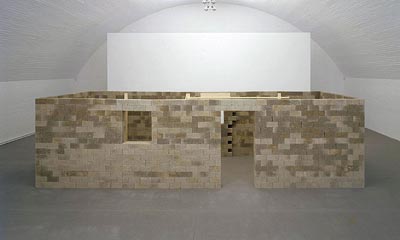 X. Baracke, 1986 Pumice, wood, photograph, approx. 190 x 200 x 700 cm Georg Herold X. Baracke, 1986 Click for English text Galerie Max Hetzler zeigt die Skulptur "X. Baracke, 1986", von Georg Herold in der Holzmarktstrasse 15-18, S-Bahnbogen 48, Berlin-Mitte. Jörg Heiser: Warum "X. Baracke"? Georg Herold: X wie zehn - die zehnte Station des Kreuzwegs. Aber es hat keiner wahrgenommen, mit einer Verbissenheit, die erstaunt. Für mich ging es zunächst um die massive Wand von Steinen, um eine gewisse schlichte physische Ausstrahlung. Und um Architektur und Konstruktion, denn drinnen ist ein Kantholz-Gerüst. In der Baracke ist ein Foto angebracht. Das Foto habe ich in Belgien in einer verrotteten, verschimmelten Kirche aufgenommen: ein lapidares Pappschild weist darauf hin, dass die zehnte Station des Kreuzwegs gerade restauriert wird. JH: Das passt also doppelt: das schnöde Pappschild und die zehnte Station, bei der Jesus seiner Kleider entledigt wird. Die Baracke ist die moderne Ruine, nicht mehr das Überbleibsel, sondern das, was nie etwas geworden ist. GH: Die Baracke als Desaster. JH: In Deutschland denkt man natürlich auch sofort an Lager, KZ. Ich muss auch sofort denken an: Gerhard Merz auf den Boden der Tatsachen holen. GH: Das ist sowieso mein Programm - Dinge vom Sockel holen, zum Beispiel "Skulptur vom Sockel erschlagen" (1992) ist auch eine Arbeit, die das deutlich macht. JH: Das Problem ist offenbar, dass man mit "armen" Materialien problemlos Erhabenheit, Aura erzeugen kann - siehe Beuys. In diesem Sinne ist Ihr Ansatz ein Gegenprogramm. GH: Ich war immer mehr ein Vertreter der realen Bestandsaufnahme. Nicht das Abgehobene, sondern die nackte Tatsache. Das ist auch meine Auffassung zum Thema "Vergangenheitsbewältigung": sie wird nicht bewältigt, sondern einfach Gegenwart bleiben. Das ist bei solchen Arbeiten wie "X. Baracke" präsent: wir leben heute nicht wo anders, sondern wir leben genau da - und auch in diesem vergangenen Moment. (Jörg Heiser im Gespräch mit Georg Herold; Auszug aus dem Buch: "Georg Herold, X. Baracke, 1986", verlegt von Holzwarth Publications, Berlin 2005, anlässlich der Ausstellung "X. Baracke" in der Galerie Max Hetzler) Die Skulptur "X. Baracke, 1986", Bimsstein, Holz, Fotografie, 190 x 200 x 700 cm, wurde erstmals 1986 im Westfälischen Kunstverein in Münster gezeigt. 1992 war die Skulptur auf der Documenta IX in Kassel ausgestellt, 2003 im Institute of Visual Culture in Cambridge, England. Georg Herold, 1947 in Jena geboren, lebt und arbeitet in Köln. Seit 1984 stellt er regelmässig in der Galerie Max Hetzler aus. Ausstellungsdauer: 6.5. - 25.6.2005 Oeffnungszeiten: Di-Sa 11 - 18 Uhr Galerie Max Hetzler Holzmarktstrasse 15-18 D-10117 Berlin Telefon +49 30 229 24 37 Fax +49 30 229 24 17 Zimmerstrasse 90/91 D-10117 Berlin-Mitte Telefon +49 30 24 04 56 30 Fax +40 30 24 04 56 32 Email info@maxhetzler.com www.maxhetzler.com Georg Herold X. Baracke, 1986 Galerie Max Hetzler is pleased to present an exhibition of the sculpture "X. Baracke, 1986", by Georg Herold. Jörg Heiser: Why "X. Baracke"? Georg Herold: X as in ten, as in the 10th Station of the Cross. But no one noticed this, quite determinedly so, which surprised me. For me it is above all about the massive wall of stone, about a certain very simple physical presence. And about architecture and construction, since inside it is a frame made of squared timber. Fixed to a wall inside the barrack is a photo which I took in Belgium of a mouldy decaying church. Nothing but a terse cardboard sign announces that the 10th Station of the Cross is in the process of being restored. JH: So that makes double sense. The nasty little cardboard sign and the 10th Station at which Jesus is stripped of his clothes. The barrack is a modern ruin, no longer a relic but something that never actually came about. GH: The barrack as a synonym for disaster. JH: In Germany one is of course immediately reminded of concentration camps. It also makes me think: bring Gerhard Merz back down to earth. GH: That's my agenda anyway. Knocking things off their pedestals. For instance, "Skulptur vom Sockel erschlagen" (Sculpture knocked off by pedestal, 1992) is one work that explicitly does this. JH: The problem seems to be that "poor" materials can easily be used to create a sense of the sublime and of aura - just take Beuys. In this respect, your approach is a counter-programme. GH: I was always more one of those who take an inventory of the real. Not of the elevated kind, just the naked facts. That's also my attitude to the issue of "coming to terms with the past". The past is not come to terms with, it simply remains the present. This is at play in a piece like "X. Baracke": we aren't living somewhere else today, we're living in precisely the same place - and in this past moment as well. (Jörg Heiser in conversation with Georg Herold, excerpt from the book: "Georg Herold, X. Baracke, 1986", published by Holzwarth Publications Berlin, 2005, on the occasion of the exhibition "Georg Herold, X. Baracke" at Galerie Max Hetzler, Berlin) The sculpture "X. Baracke, 1986", pumice stone, wood, photograph, 190 x 200 x 700 cm, was shown for the first time in 1986 at Westfälischer Kunstverein (Münster); it was then exhibited in 1992 at Documenta IX (Kassel) and at the Institute of Visual Culture (Cambridge) in 2003. Georg Herold, born 1947 in Jena, lives and works in Cologne. He exhibits at Galerie Max Hetzler since 1984. Exhibition: January 15 - February 26, 2005 Gallery hours: Tues-Sat 11 am - 6 pm |